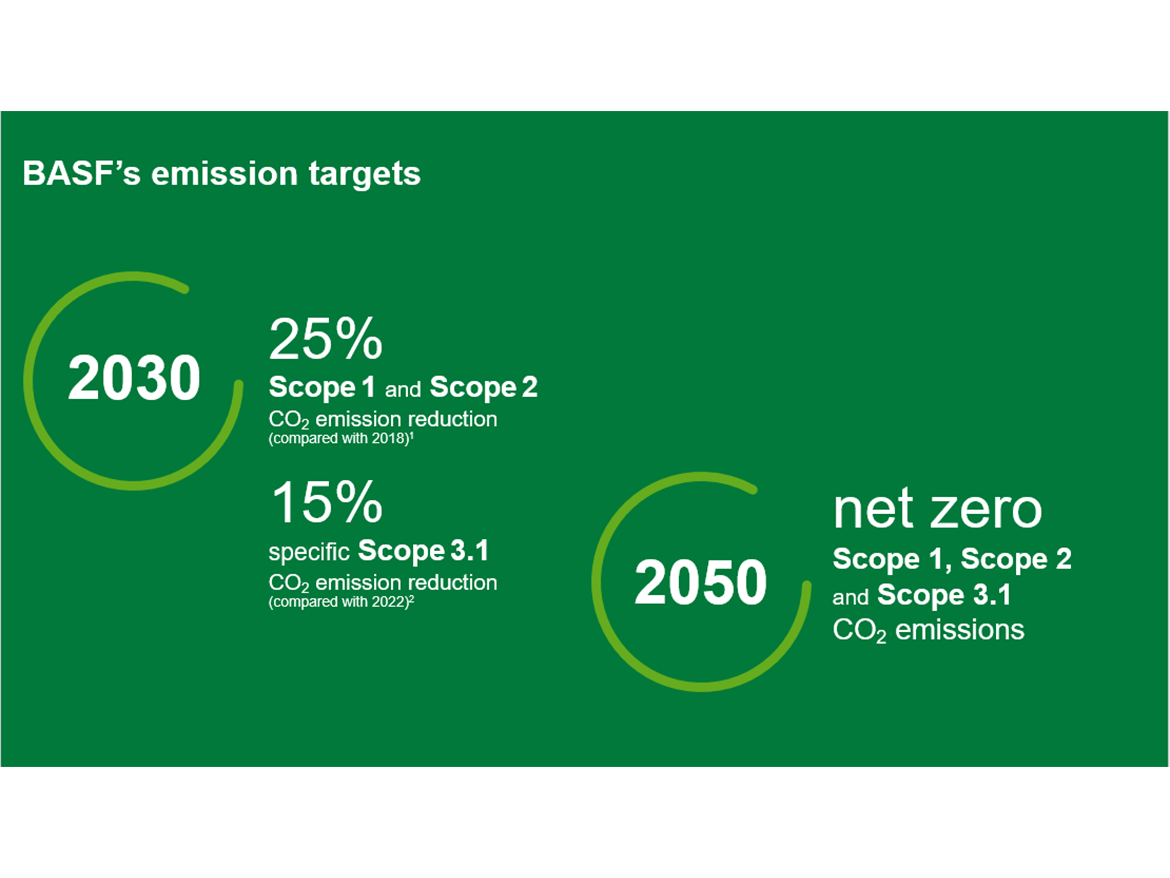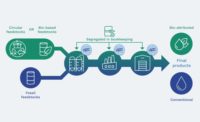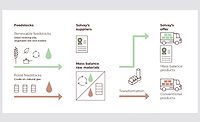Biomass Balance
Paving the Way for a Sustainable Future

If you have attended any coatings conference or technical talk recently, you can’t go long without seeing or hearing mention of the word “sustainability.” From the European Green Deal to the Inflation Reduction Act to California Senate Bills requiring greenhouse gas (GHG) reporting and reduction planning, industry regulation is ramping up. Consumer sentiment has become more vocal too, especially with Millennial and Gen Z consumers, who want accountability from companies to lower their carbon footprint and increase circularity. These days, sustainability is not just a buzzword, it’s an ever-growing trend in our industry.
So how do we, as a coatings industry, make strides to improve our impact on the planet? As part of BASF’s climate goals, we have developed a Circular Economy Program and action plans. By 2030, BASF aims to reduce our Scope 1 and Scope 2 CO2 emissions by 25% (compared with 2018), and our Scope 3.1 emissions by 15% (compared with 2022). And we have set a target to become net zero by 2050 (Figures 1 and 2).

By 2050, we want to achieve net-zero greenhouse gas emissions for our production (Scope 1), our energy purchases (Scope 2)1, and our purchase of raw materials (Scope 3.1).2 We have set ourselves ambitious milestones on this path: By 2030, we want to reduce Scope 1 and Scope 2 emissions by 25% compared with 2018—while growing production volumes in parallel.
Compared with 1990, this translates into a reduction of around 60%. As we become increasingly transparent about our upstream emissions and want to offer more products with a low carbon footprint to our customers, we have set ourselves another intermediate target: We aim to reduce our raw-materials-related emissions specifically by 15% by 2030 from the 2022 baseline.2
 The core elements of a circular economy include reusing resources, avoiding waste, and optimizing product features with respect to the entire product life cycle. BASF’s Circular Economy Program focuses on three action areas: increasing the use of recycled and renewable feedstocks, innovative material cycles, and new business models for the circular economy, including digital and service-based models.
The core elements of a circular economy include reusing resources, avoiding waste, and optimizing product features with respect to the entire product life cycle. BASF’s Circular Economy Program focuses on three action areas: increasing the use of recycled and renewable feedstocks, innovative material cycles, and new business models for the circular economy, including digital and service-based models.
To meet these ambitious targets, one action area focuses on increasing the use of renewable feedstocks. In this article, we explore how BASF's biomass balance products are contributing to a sustainable future by replacing the use of fossil resources with renewable resources. These products are playing a vital role in achieving our climate goals by reducing greenhouse gas emissions and enabling a circular economy.
The biomass balance approach is a well-tested model that has been successfully used in other industries, such as cocoa and palm oil production, for a few decades. The biomass balance approach works on the same principle as green electricity. It involves a chain-of-custody model, where a mix of renewable and fossil resources is fed into the company's value chain at the beginning of the production process. Independent certification confirms that the necessary amount of renewable raw materials was used and the mass-balanced products are identical to their fossil-based counterparts in terms of formulation and quality.
 In Figure 3, we see in more detail how the chain-of-custody model can be applied to BASF’s Verbund process. At the beginning of the value chain, biomass, such as bio-naphtha or biomethane, is fed into the steam cracker along with the fossil-based natural gas. Once the raw materials have been cracked into basic organic chemicals, they are converted through the usual chemical processes to become the finished goods (in this case, a latex binder).
In Figure 3, we see in more detail how the chain-of-custody model can be applied to BASF’s Verbund process. At the beginning of the value chain, biomass, such as bio-naphtha or biomethane, is fed into the steam cracker along with the fossil-based natural gas. Once the raw materials have been cracked into basic organic chemicals, they are converted through the usual chemical processes to become the finished goods (in this case, a latex binder).
The biomass raw materials are physically connected and traced throughout the entire process to the final product, but since the raw materials are mixed (and the biomass diluted through the value chain), the end product is chemically indistinguishable from its fossil-based equivalent. The mass balance process uses a third-party certifier to properly allocate product carbon footprint (PCF) savings to the final product.
Certification for biomass balance products is conducted by third-party certifiers such as RedCert2, ISCC+, and RSB. These certifiers review the entire value chain to ensure that the biomass balance products are physically connected to the start of the chain and that sufficient renewable feedstock is allocated to the end product. The certification process adds credibility to the products.
Using biomass balance products offers circular solutions to customers. They benefit from lower CO2 footprints and savings on fossil resources without compromising product quality and performance. These products provide a drop-in solution with significantly lower product carbon footprints.
Our company is focusing on the architectural coatings market as a key area for the development and advancement of biomass balance products. Customers in this market are increasingly concerned about lowering their Scope 3 emissions, and biomass balance products offer a viable solution to achieve carbon footprint reduction goals. With our Acronal® MB line for architectural paint, reductions of up to 50% can be realized. These savings can then be used to contribute to net PCF reductions in our customers’ cans of paint.
In some cases, the PCF reduction achieved through biomass balance is even greater than the impact of replacing monomers with traceable raw materials. While BASF offers bio-based materials in its Dispersions and Resins division, supplying 100% bio-based acrylic dispersions is currently not feasible due to limited alternatives for multiple monomers and building blocks. On the other hand, 100% biomass balance products can be offered now, maximizing PCF benefits for our customers. Nicholas Foley Ph.D., North American Architectural R&D Manager, is excited about BASF’s biomass balance offering, saying “what I love about our BMB program is that we can bring fast, impactful PCF savings to our market where it is valued.”
BASF's Dispersions and Resins division now has biomass balance-certified products within its architectural portfolio. These products contribute to GHG emission reductions and offer significant CO2 savings. BASF formally launched its Acronal MB line at the 2023 Western Coatings Show, highlighting the sustainability benefits of biomass balance products (Figure 4).

“As BASF continues to innovate for the future of architectural coatings, we’re extremely excited to offer our biomass balance product line to the North American market,” remarks Justin Davis, Business Director for Architectural Coatings. “This new product offering not only reflects BASF’s commitment to creating a sustainable future, but also signifies a transformative shift toward eco-conscious solutions for the architectural coatings industry more broadly.”
By replacing fossil fuels with renewable resources, biomass balance products contribute to reducing greenhouse gas emissions and enabling a circular economy. Customers can confidently choose biomass balance products, knowing that they offer the same technical performance as their fossil-based counterparts.
For more information on BASF's biomass balance certified products, click here.
Contributors: Nicholas Foley, Ph.D, R&D Manager and Sr. Scientist; and Justin Davis, Business Director for Architectural Coatings, Charlotte NC; and Samane Mehrevar, Global Sustainability Manager, Ludwigshafen, Germany.
References
1 Scope 1 and Scope 2 (excluding the sale of energy to third parties). Greenhouse gases are converted into CO2 equivalents (CO2e) in accordance with the Greenhouse Gas Protocol.
2 Scope 3.1, raw materials excluding battery materials, services and technical goods, excluding greenhouse gas emissions from BASF trading business. Future adjustment of the baseline in line with the Together for Sustainability guideline possible depending on the availability of further primary data.
ACRONAL® is a registered trademark of BASF Group.
*All images courtesy of BASF.
Looking for a reprint of this article?
From high-res PDFs to custom plaques, order your copy today!






